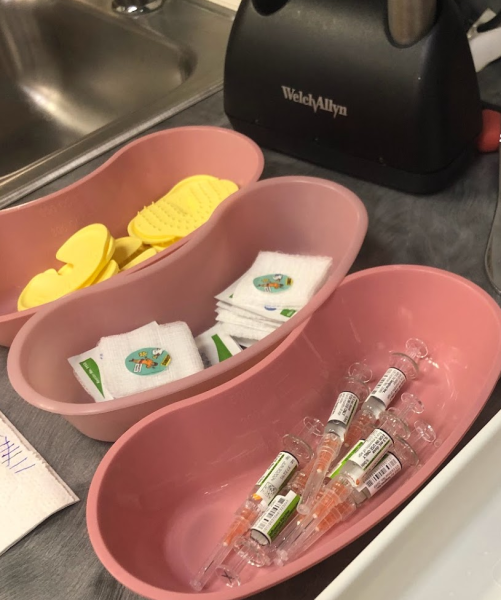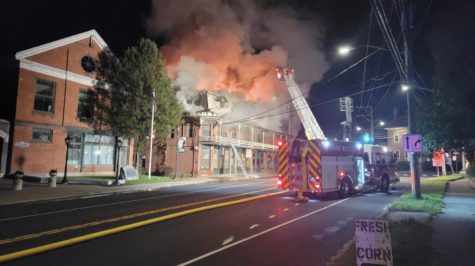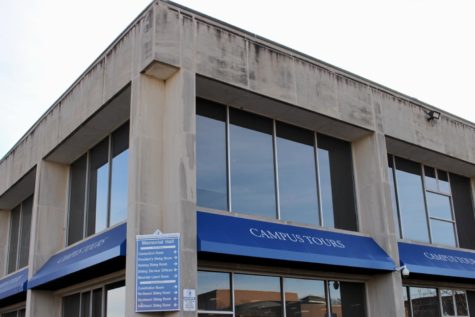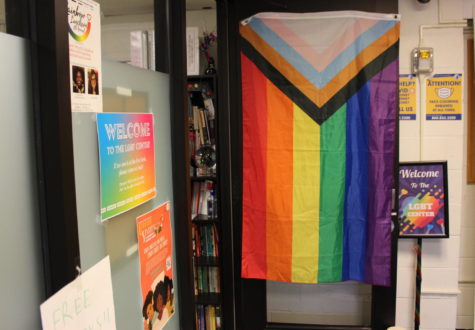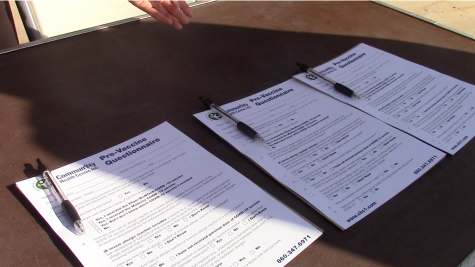Mold Growing in James Hall
October 27, 2021
Several students residing in James Hall are living with leaking air conditioning units and some claim mold is growing in their walls and ceilings.
At least one confirmed case of mold and several other students who claim it is in their walls and has made them sick.
Every room in James Hall has its own independent air conditioning unit, which gives the student’s the ability to control their own settings in their room.
Having this luxury was great until some residents, including senior Harry Schmitt, experienced water leaking out of their AC units during the first two weeks of the fall semester.
“I had water that kept leaking out of the air conditioner in my bedroom and it was not fixed for several weeks,” Schmitt said. “The university said it was coming from the bedroom above me, but it still took several weeks for it to fully go away.”
Schmitt said the university did very little to help his leaky air conditioner situation and said that he is still unsure if it is fully taken care of. According to Schmitt, he wouldn’t be surprised at all if there was mold growing in the walls due to the university’s disregard for their students’ living conditions.
“Even after I filed multiple reports and complaints after that they still didn’t come in person to check it out and make sure it was gone,” Schmitt said. “If there is mold then it’s most likely due to leaks that aren’t being actively fixed.”
Central Connecticut State University’s Environmental Health and Safety director Sal Cintorino, said that there were only a couple of isolated cases in James Hall that concerned failing air conditioning units and mold growth.
Cintorino said that a few students reported a leakage from their condensate pans in their AC units which raised safety concerns. Water was reportedly all over the floors and the fan blowing on it resulted in extra moisture in the air.
There was certainly a detection of mold growing in this particular room and students were relocated immediately, Cintorino said.
“The mold mitigation team and I went and inspected it and we recognized that there was a problem there,” Cintorino said. “We relocated the students. We made the repair. We took the mitigating factors and replaced everything that touched the walls and used special products that removed it all safely.”
The students who were relocated had money put onto their bluechip cards for the inconvenience and were explained in full detail of what exactly happened, Cintorino said.
Failure in some of the air conditioning units wasn’t the only thing contributing to the suspected mold growth in James.
To prepare for a full capacity school year, CDC guidelines for COVID-19 prompted colleges across the nation to have more outside air flowing throughout their buildings, Cintorino said.
Due to these guidelines being in place, more humidity and moisture traveled throughout campus buildings and helped promote mold growth, especially during the warmer months of August and September.
“During the summer months of August and September we were bringing in more humidity. That’s not normal but it’s something that we had to adjust to,” Cintorino said. “As we reopen the university we have to realize that there will be some challenges. The few isolated incidents in James were partially caused by that humidity.”
Connecticut experienced a very humid and wet summer compared to previous years, CCSU’s Environmental Health and Safety assistant Kelly Selby said. She said this kind of weather made it more challenging to keep the moisture out.
Residents in James were emailed a notice back in September and that informed them on the importance of having their AC units on all times and to not open their windows. This was to avoid humidity in the building and to not promote mold growth.
Some of James’ residents however, like Jeremiah Nugent, have even said that they think they caught a cold from the suspected mold in their room.
“A couple of residents that I am friends with had respiratory issues early on in the semester,” Nugent said. “We all thought it was something in the vents. I had a bad cough for about a week.”
Cintorino shut this down immediately and said that there is no correlation between student’s getting sick and these particular mold cases. Cintorino said each unit is independent and air vents are not shared in between each room.
He also said that his department works very closely with Residence Life and Health Services to ensure that there is no detection of mold or moisture.
James Hall was constructed in 1994 and is the largest coed residence hall with 415 students. According to Residence Life, James Hall is a popular choice for new and returning students alike because of the two computer labs located inside the building and because it has air conditioning.
Despite its good reputation, some residents living in James Hall have said that their air conditioning system has not been properly taken care of during and in between semesters.
“I think there’s something in the AC system here in James that could be moldy,” Nugent said. “It doesn’t seem to be cleaned correctly between semesters and that could be the issue.”
All residential buildings, including James, were inspected thoroughly before school began, Cintorino said.
The alleged mold situation in James has students from other residential halls concerned for their own safety. According to Sam Wytas, a freshman residing in Sheridan Hall, his roommate heard about the girl in James who had mold in her room and wanted to have a mold inspection of their room done immediately.
“I know a girl living in James Hall that had mold all over one of the walls and onto the ceilings,” Wytas said. “My roommate started to freak out so he told one of our RAs to report it and have an inspection of the room.”
Wytas said the mold mitigation team didn’t find anything in their room and that he and his roommate were very relieved.
After the suspected mold situation started to get around campus, Cintorino said his office was flooded with concerns. His team had to inspect a couple of dorm rooms in Sheridan Hall to ensure the concerned students that they didn’t have any mold.
Most reports were concluded to be dust particles and spray paint marks that resembled black spots seen in mold. Cintorino said that they had to conduct mold tests in front of the worried residents to prove that there was none detected.
CCSU’s Environmental Health and Safety department wants to assure students that they are staying on top of reports of mold and are actively trying to stay on top of this issue to prevent future outbreaks.
“Our job is to make sure that when there is a case, it’s all about how we respond to it,” Cintorino
said. “We need to be responsive and quickly responsive and to always have a plan. We always have extra rooms set aside so we can do relocation if necessary. We also have a team that’s ready to jump in there and mitigate the situation so students can feel safe while on campus.”




